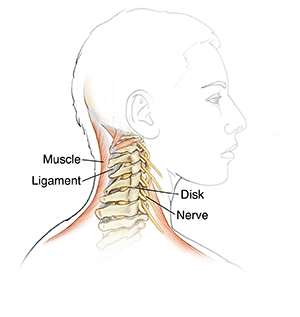Neck Pain
There are several possible causes of neck pain when there is no injury:
- You can get a minor ligament sprain or muscle strain from a sudden minor neck movement. Sleeping with your neck in an awkward position can also cause this.
- Some people respond to emotional stress by tensing the muscles of their neck, shoulders, and upper back. Chronic spasm in these muscles can cause neck pain and sometimes headaches.
- Gradual wear and tear of the joints in the spine can cause degenerative arthritis. This can be a source of occasional or chronic neck pain.
- The spinal discs may bulge and put pressure on a nearby spinal nerve. This can happen as a natural result of aging or repeated small injuries to the neck. The spinal discs are the cushions between each spinal bone. This causes tingling, pain or numbness that spreads from the neck to the shoulder, arm or hand on one side.
 |
Acute neck pain usually gets better in 1 to 2 weeks. Neck pain related to disc disease, arthritis in the spinal joints or spinal stenosis can become chronic and last for months or years. Spinal stenosis is narrowing of the spinal canal.
X-rays are usually not ordered for the initial evaluation of neck pain. However, X-rays may be done if you had a forceful physical injury, such as a car accident or fall. X-rays and other tests may also be done if neck pain continues and does not respond to medical treatment.
Home care
- Rest and relax the muscles. Use a comfortable pillow that supports the head. It should also help keep the spine in a neutral position. The position of the head should not be tilted forward or backward. A rolled up towel may help for a custom fit.
-
Some people find relief with heat. Heat can be applied with either a warm shower or bath or a warm moist towel and massage.
-
Some people prefer cold packs. You can make an ice pack by filling a plastic bag that seals at the top with ice cubes or crushed ice and then wrapping it with a thin towel. Try both and use the method that feels best for 15 to 20 minutes, several times a day.
-
Whether using ice or heat, be careful that you do not injure your skin. Never put ice directly on the skin. Always wrap the ice in a towel or other type of cloth. This is very important, especially in people with poor skin sensation.
-
Try to reduce your stress level. Emotional stress can lead to neck muscle tension and get in the way of or delay the healing process.
-
You may use over-the-counter pain medicine to control pain, unless another medicine was prescribed. If you have chronic liver or kidney disease or ever had a stomach ulcer or GI bleeding, talk with your healthcare provider before using these medicines.
Follow-up care
Follow up with your healthcare provider if your symptoms do not show signs of improvement after one week. Physical therapy or further tests may be needed. If X-rays, CT scans, or MRI scans were taken, you will be told of any new findings that may affect your care.
|
When to seek medical advice
Call 911 if you have:
- Sudden weakness or numbness in one or both arms
- Neck swelling, difficulty or painful swallowing
- Difficulty breathing
- Chest pain
Call your healthcare provider right away if any of these occur:
- A severe injury to your head or neck
- Severe neck pain
- No control over your bladder or bowels
- Pain that does not get better after you treat it at home for 1 week
- Pain becomes worse or spreads into one or both arms
- Increasing headache
- Fever of 100.4°F (38°C) or higher or as directed by your healthcare provider
|